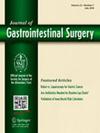Tunnel anastomosis: a modified flap technique in esophagogastrostomy as a novel antireflux technique after proximal gastrectomy
IF 2.2
3区 医学
Q3 GASTROENTEROLOGY & HEPATOLOGY
引用次数: 0
Abstract
Background
The prevalence of proximal gastric cancer (PGC) has been increasing rapidly worldwide. Postoperative reflux esophagitis after conventional esophagogastrostomy (EG) is a major problem that haunts surgeons. This study designed a novel antireflux technique called tunnel anastomosis in EG after proximal gastrectomy (PG). This study aimed to present the detailed procedures of tunnel anastomosis and to assess its safety and feasibility by comparing the surgical outcomes, reflux, and nutritional status of patients undergoing tunnel anastomosis and those undergoing double-tract jejunal interposition reconstruction (DTJIR).
Methods
A total of 1718 patients undergoing gastrectomy were enrolled in this study. However, only 150 patients undergoing PG were ultimately analyzed, of which 21 patients underwent tunnel anastomosis and 129 patients underwent DTJIR. Propensity score matching (PSM) was used to reduce biases.
Results
After 1:1 PSM, there were 21 patients in both groups. No significant differences were observed between the 2 groups regarding surgical approach, blood loss, operative time, reconstruction time, postoperative hospital stay, morbidity, and mortality. The incidence of reflux esophagitis in both groups was 9.5% (2/21) according to the endoscopic examination at the 12-month postoperative follow-up. No patient in the tunnel group was classified as grade B or higher according to the Los Angeles classification. Patients in the tunnel and DTJIR groups exhibited comparable postoperative nutritional status when assessing the body weight, albumin levels and prognostic nutritional index value at 3 and 6 months after surgery.
Conclusion
Tunnel anastomosis is a safe technique that offers a robust antireflux effect and can be performed in some suitable patients with PGC.
隧道吻合术--食管胃造口术中的一种改良皮瓣技术,是近端胃切除术后的一种新型抗反流技术。
背景:近端胃癌(PGC)的发病率在全球范围内迅速上升。传统食管胃切除术(EG)术后反流性食管炎是困扰外科医生的一大难题。我们在近端胃切除术后的食管胃切除术中设计了一种新的抗反流技术--隧道吻合术。本研究旨在介绍隧道式吻合术的详细过程,并通过比较隧道式吻合术与双道空肠间置重建术(DTJIR)患者的手术效果、反流和营养状况,评估其安全性和可行性。最终分析了150名接受胃切除术的患者,其中21名患者接受了隧道吻合术,129名患者接受了DTJIR。研究采用倾向评分匹配法(PSM)来减少偏差:经过 1:1 PSM 后,两组患者均为 21 人。两组患者在手术方式、失血量、手术时间、重建时间、术后住院时间、发病率和死亡率方面均无明显差异。根据术后 12 个月随访的内镜检查结果,两组反流性食管炎的发生率均为 9.5%(2/21)。根据洛杉矶分级法,隧道组患者中没有人被列为 B 级或以上。根据术后 3 个月和 6 个月的体重、白蛋白水平和 PNI 值评估,隧道组和 DTJIR 组患者的术后营养状况相当:隧道式吻合术是一种安全的技术,具有很强的抗反流效果,适用于部分 PGC 患者。
本文章由计算机程序翻译,如有差异,请以英文原文为准。
求助全文
约1分钟内获得全文
求助全文
来源期刊
CiteScore
5.50
自引率
3.10%
发文量
319
审稿时长
2 months
期刊介绍:
The Journal of Gastrointestinal Surgery is a scholarly, peer-reviewed journal that updates the surgeon on the latest developments in gastrointestinal surgery. The journal includes original articles on surgery of the digestive tract; gastrointestinal images; "How I Do It" articles, subject reviews, book reports, editorial columns, the SSAT Presidential Address, articles by a guest orator, symposia, letters, results of conferences and more. This is the official publication of the Society for Surgery of the Alimentary Tract. The journal functions as an outstanding forum for continuing education in surgery and diseases of the gastrointestinal tract.

 求助内容:
求助内容: 应助结果提醒方式:
应助结果提醒方式:


